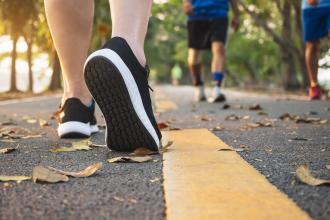A walk in nature: The superfood of physical activities
Regular physical activity (e.g., a daily walk at a moderate pace for 30 minutes) can lessen the risk (by up to 30%) as well as improve the outcome in close to 40 chronic medical disorders.[1] This has led to a recommendation by the Canadian Medical Association and Doctors of BC to include a physical activity history in the vital signs section of all electronic medical record systems, encouraging physicians to regularly monitor and review their patients’ physical activity levels and counsel them accordingly.[2]
We know that physicians can be effective at promoting behavioral change. Efforts that encourage smoking cessation have been very effective, and similarly, we can advance the health benefits of regular physical activity. However, matching the correct physical activity to the unique needs of an individual patient in the limited time of our doctor-patient encounters can be problematic.
When it comes to nutrition, some foods (i.e., so-called superfoods—blueberries, kale, etc.) give you more benefits than others. Similarly, as a physical activity, a 30-minute walk in nature offers several benefits that other activities do not.
The Japanese practice of shinrin-yoku, or forest bathing, has received recent attention in the lay press. There is increasing evidence that walking in nature can enhance immunity and improve chronic disease states (hypertension, coronary artery disease, diabetes, COPD, depression), and that the effects are greater than those gained from walks in an urban environment.[3]
A complete explanation of why walking in nature has such benefits is not clear. Humans have always been drawn to nature to relax, to find relief from everyday life stressors, to clear their head, and to experience beauty. Physiological studies indicate the lessening of sympathetic arousal and more parasympathetic activity in nature. Japanese research on phytoncides, natural wood oils emitted by plants and trees, suggests they have a number of positive effects on the immune system.[4]
The subgenual prefrontal cortex exhibits increased activity during sadness and when ruminating (negative self-reflection) in both healthy and depressed individuals. MRI data demonstrate a quieting of subgenual activity with a walk in nature compared to a walk of similar length and intensity in an urban area.[5]
While the physical benefits of walking in nature are the same as for an urban walk, studies from Austria and Iceland comparing a walk in the Alps or Icelandic forests versus a walk on a treadmill in a gym indicate the nature intervention resulted in a further improved mood, and the subjective effort of the physical activity was perceived to be easier with the green intervention.[6,7]
Locally, the BC Parks Foundation introduced a Parks Prescription program, which encourages physicians to prescribe nature to their patients (www.parkprescriptions.ca).
So when we counsel our patients to increase their physical activity (even more of a necessity during our current pandemic), a walk at a moderate pace is an inexpensive intervention that the majority could accomplish. When suggesting walking, why not encourage this superfood of exercise, a walk in nature, which will add something extra for their physical and mental health.
—Ronald A. Remick, MD, FRCPC
hidden
This article is the opinion of the Athletics and Recreation Committee, a subcommittee of Doctors of BC’s Council on Health Promotion, and is not necessarily the opinion of Doctors of BC. This article has not been peer reviewed by the BCMJ Editorial Board.
References
1. Lim SS, Vos T, Flaxman AD, et al. A comparative risk assessment of burden of disease and injury attributable to 67 risk factors and risk factor clusters in 21 regions, 1990-2010: A systematic analysis for the Global Burden of Disease Study 2010. Lancet 2012;380(9859):2224-2260.
2. Canadian Medical Association. Healthy behaviours—promoting physical activity and healthy eating. 2015. Accessed 19 January 2021. http://policybase.cma.ca/dbtw-wpd/Policypdf/PD15-12.pdf.
3. Wen Y, Yan Q, Pan Y, et al. Medical empirical research on forest bathing (Shirin-yoku): A systemic review. Environ Health Prev Med 2019:24:70.
4. Li Q, Kobayashi M, Wakayama Y, et al. Effect of phytoncide from trees on human natural killer cell function. Int J Immunopathol Pharmacol 2009;22:951-959.
5. Bratman GN, Hamilton JP, Hahn KS, et al. Nature experience reduces rumination and subgenual prefrontal cortex activation. Proc Natl Acad Sci USA 2015;112:8567-8572.
6. Niedermeier M, Einwanger J, Hartl A, Kopp M. Affective responses in mountain hiking—A randomized crossover trial focusing on differences between indoor and outdoor activity. PLoS One 2017;12:e0177719.
7. Olafsdottir G, Cloke P, Schulz A, et al. Health benefits of walking in nature: A randomized controlled study under conditions of real-life stress. Environ Behav 2020;52:248-274.

